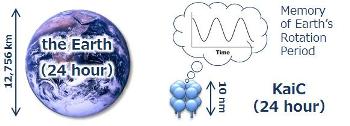Jun 26 2015
A collaborative group of Japanese researchers has demonstrated that the Earth's daily rotation period (24 hours) is encoded in the KaiC protein at the atomic level, a small, 10 nm-diameter biomolecule expressed in cyanobacterial cells.
 This image shows Earth and the circadian clock protein KaiC. Credit:IMS/NINS
This image shows Earth and the circadian clock protein KaiC. Credit:IMS/NINS
This research group included: Dr. Jun Abe, Assistant Prof. Atsushi Mukaiyama, and Prof. Shuji Akiyama of the Institute for Molecular Science (IMS) Research Center of Integrative Molecular Systems (CIMoS); Assistant Prof. Toshifumi Mori and Prof. Shinji Saito of the Department of Theoretical and Computational Molecular Science at IMS; Designated Prof. Takao Kondo of Nagoya University; and Assistant Prof. Eiki Yamashita of the Osaka University Institute for Protein Research.
The results of this joint research will help elucidate a longstanding question in chronobiology: How is the circadian period of biological clocks determined? The results will also help understand the basic molecular mechanism of the biological clock. This knowledge might contribute to the development of therapies for disorders associated with abnormal circadian rhythms.
The results will be disclosed online on June 25, 2015 (North American Eastern Standard Time) in ScienceExpress, the electronic version of Science, published by the American Association for the Advancement of Science (AAAS).
1. Research Background
In accordance with diurnal changes in the environment (notably light intensity and temperature) resulting from the Earth's daily rotation around its axis, many organisms regulate their biological activities to ensure optimal fitness and efficiency. The biological clock refers to the mechanism whereby organisms adjust the timing of their biological activities. The period of this clock is set to approximately 24 hours. A wide range of studies have investigated the biological clock in organisms ranging from bacteria to mammals. Consequently, the relationship between the biological clock and multiple diseases has been clarified. However, it remains unclear how 24-hour circadian rhythms are implemented.
The research group mentioned above addressed this question using cyanobacteria. The cyanobacterial circadian clock can be reconstructed by mixing three clock proteins (KaiA, KaiB, and KaiC) and ATP. A study published in 2007 showed that KaiC ATPase activity, which mediates the ATP hydrolysis reaction, is strongly associated with circadian periodicity. The results of that study indicated that the functional structure of KaiC could be responsible for determining the circadian rhythm.
2. Research Results
KaiC ATPase activity exhibits a robust circadian oscillation in the presence of KaiA and KaiB proteins (Image 2). In the study reported here, the temporal profile of KaiC ATPase activity exhibited an attenuating and oscillating component even in the absence of KaiA and KaiB. A close analysis revealed that this signal had a frequency of 0.91 day-1, which approximately coincided with the 24-hour period. Thus, KaiC is the source of a steady cycle that is in tune with the Earth's daily rotation.
To identify causal structural factors, the N-terminal domain of KaiC was analyzed using high-resolution crystallography. The resultant atomic structures revealed the underlying cause of KaiC's slowness relative to other ATPases (Image 3). "A water molecule is prevented from attacking into the ideal position (a black dot in Image 3) for the ATP hydrolysis by a steric hindrance near ATP phosphoryl groups. In addition, this hindrance is surely anchored to a spring-like structure derived from polypeptide isomerization," elaborates Dr. Jun Abe. "The ATP hydrolysis, which involves access of a water molecule to the bound ATP and reverse isomerization of the polypeptide, is expected to require a significantly larger amount of free energy than for typical ATP hydrolysis. Thus, the three-dimensional atomic structure discovered in this study explains why the ATPase activity of KaiC is so much lower (by 100- to 1,000,000-fold) than that of typical ATPase molecules."
The circadian clock's period is independent of ambient temperature, a phenomenon known as temperature compensation. One KaiC molecule is composed of six identical subunits, each containing duplicated domains with a series of ATPase motifs. The asymmetric atomic-scale regulation by the aforementioned mechanism dictates a feedback mechanism that maintains the ATPase activity at a constant low level. The authors of this study discovered that the Earth's daily rotation period (24 hours) is implemented as the time constant of the feedback mechanism mediated in this protein structure.
3. Technological Implications
KaiC and other protein molecules are capable of moving on short time scales, on the order of 10-12 to 10-1 seconds. This study provides the first atomic-level demonstration that small protein molecules can generate 24-hour rhythms by regulating molecular structure and reactivity. Lab head and CIMoS Director Porf. Shuji Akiyama sees, "The fact that a water molecule, ATP, the polypeptide chain, and other universal biological components are involved in this regulation suggests that humans and other complex organisms may also share a similar molecular machinery. In the crowded intracellular environment that contains a myriad of molecular signals, KaiC demonstrates long-paced oscillations using a small amount of energy generated through ATP consumption. This clever mechanism for timekeeping in a noisy environment may inspire development of highly efficient and sustainable chemical reaction processes and molecular-system-based information processing."